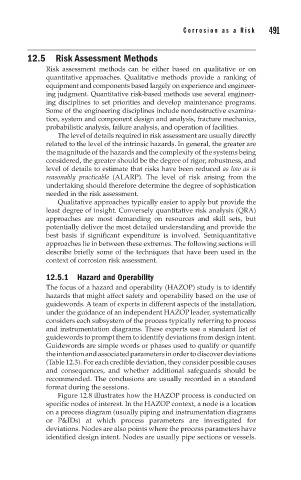Page 525 - Corrosion Engineering Principles and Practice
P. 525
490 C h a p t e r 1 2 C o r r o s i o n a s a R i s k 491
12.5 Risk Assessment Methods
Risk assessment methods can be either based on qualitative or on
quantitative approaches. Qualitative methods provide a ranking of
equipment and components based largely on experience and engineer-
ing judgment. Quantitative risk-based methods use several engineer-
ing disciplines to set priorities and develop maintenance programs.
Some of the engineering disciplines include nondestructive examina-
tion, system and component design and analysis, fracture mechanics,
probabilistic analysis, failure analysis, and operation of facilities.
The level of details required in risk assessment are usually directly
related to the level of the intrinsic hazards. In general, the greater are
the magnitude of the hazards and the complexity of the systems being
considered, the greater should be the degree of rigor, robustness, and
level of details to estimate that risks have been reduced as low as is
reasonably practicable (ALARP). The level of risk arising from the
undertaking should therefore determine the degree of sophistication
needed in the risk assessment.
Qualitative approaches typically easier to apply but provide the
least degree of insight. Conversely quantitative risk analysis (QRA)
approaches are most demanding on resources and skill sets, but
potentially deliver the most detailed understanding and provide the
best basis if significant expenditure is involved. Semiquantitative
approaches lie in between these extremes. The following sections will
describe briefly some of the techniques that have been used in the
context of corrosion risk assessment.
12.5.1 Hazard and Operability
The focus of a hazard and operability (HAZOP) study is to identify
hazards that might affect safety and operability based on the use of
guidewords. A team of experts in different aspects of the installation,
under the guidance of an independent HAZOP leader, systematically
considers each subsystem of the process typically referring to process
and instrumentation diagrams. These experts use a standard list of
guidewords to prompt them to identify deviations from design intent.
Guidewords are simple words or phases used to qualify or quantify
the intention and associated parameters in order to discover deviations
(Table 12.3). For each credible deviation, they consider possible causes
and consequences, and whether additional safeguards should be
recommended. The conclusions are usually recorded in a standard
format during the sessions.
Figure 12.8 illustrates how the HAZOP process is conducted on
specific nodes of interest. In the HAZOP context, a node is a location
on a process diagram (usually piping and instrumentation diagrams
or P&IDs) at which process parameters are investigated for
deviations. Nodes are also points where the process parameters have
identified design intent. Nodes are usually pipe sections or vessels.

